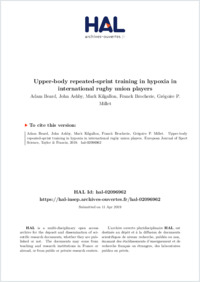Upper-body repeated-sprint training in hypoxia in international rugby union players.
- Beard A ISSUL, Institute of Sport Sciences, Faculty of Biology and Medicine, University of Lausanne , Lausanne , Switzerland.
- Ashby J Welsh Rugby Union, National Centre of Excellence , Vale of Glamorgan , Wales.
- Kilgallon M Welsh Rugby Union, National Centre of Excellence , Vale of Glamorgan , Wales.
- Brocherie F Laboratory Sport, Expertise and Performance (EA 7370), Research Department, French Institute of Sport , Paris , France.
- Millet GP ISSUL, Institute of Sport Sciences, Faculty of Biology and Medicine, University of Lausanne , Lausanne , Switzerland.
- 2019-03-19
Published in:
- European journal of sport science. - 2019
Repeated-sprint training in hypoxia
competition
repeated-sprint ability
rugby union
team sports
upper limbs
Adult
Altitude
Athletic Performance
Football
Humans
Hypoxia
Male
Physical Conditioning, Human
Young Adult
English
This study investigated the effects of upper-body repeated-sprint training in hypoxia vs. in normoxia on world-level male rugby union players' repeated-sprint ability (RSA) during an international competition period. Thirty-six players belonging to an international rugby union male national team performed over a 2-week period four sessions of double poling repeated-sprints (consisting of 3 × eight 10-s sprints with 20-s passive recovery) either in normobaric hypoxia (RSH, simulated altitude 3000 m, n = 18) or in normoxia (RSN, 300 m; n = 18). At pre- and post-training intervention, RSA was evaluated using a double-poling repeated-sprint test (6 × 10-s maximal sprint with 20-s passive recovery) performed in normoxia. Significant interaction effects (P < 0.05) between condition and time were found for RSA-related parameters. Compared to Pre-, peak power significantly improved at post- in RSH (423 ± 52 vs. 465 ± 69 W, P = 0.002, η²=0.12) but not in RSN (395 ± 65 vs. 397 ± 57 W). Averaged mean power was also significantly enhanced from pre- to post-intervention in RSH (351 ± 41 vs. 388 ± 53 W, P < 0.001, η²=0.15), while it remained unchanged in RSN (327 ± 49 vs. 327 ± 43 W). No significant change in sprint decrement (P = 0.151, η² = 0.02) was observed in RSH (-17 ± 2% vs. -16 ± 3%) nor RSN (-17 ± 2% vs. -18 ± 4%). This study showed that only four upper-body RSH sessions were beneficial in enhancing repeated power production in international rugby union players. Although the improvement from RSA to game behaviour remains unclear, this finding appears of practical relevance since only a short preparation window is available prior to international games.
- Language
-
- English
- Open access status
- green
- Identifiers
-
- DOI 10.1080/17461391.2019.1587521
- PMID 30880627
- Persistent URL
- https://folia.unifr.ch/global/documents/29939
Statistics
Document views: 18
File downloads:
- fulltext.pdf: 0
